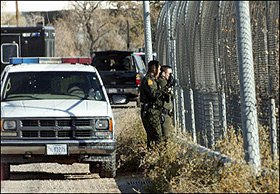 |
 |
 |
 Editorials | January 2006 Editorials | January 2006  
Why Mexico Helps US Fight Terror
 Faye Bowers - Christian Science Monitor Faye Bowers - Christian Science Monitor


| | US Customs and Border Patrol agents keep watch on a creek separating the US and Mexico as the motorcade of US President George W. Bush passes by in El Paso, Texas. (AFP/Mandel Ngan) |
A top priority of the United States government is to prevent a determined terrorist from crossing the US- Mexico border. It is also becoming a primary mission for Mexico - and the first place it's focusing on is the 375-mile, desolate stretch of land that abuts Arizona.

In addition to sharing intelligence and cooperating on investigations with its US counterparts in Arizona, Mexico last year set up three checkpoints along known human-smuggling routes on its side of the border and plans to add two more.

Between August, when the checkpoints became operational, and December, Mexican officials stopped 1,277 non-Mexicans (OTMs, for "other than Mexicans") from crossing into Arizona, according to a Mexican government report obtained by the Monitor. The report shows that most of the OTMs came from Central and South America, but seven are listed as Iraqis.

FBI officials decline to say if they know what became of the Iraqis detained in Mexico. The seven - believed to have been apprehended simultaneously at one checkpoint - could be members of a single family or unrelated individuals simply trying to find a better life in the US. But they also could have been trying to illegally cross the southern border for nefarious purposes.

That's where the additional checkpoints could prove crucial.

The Mexican government has "an immense interest in making sure terrorists don't cross from Mexico into the US," says Ben Peres of the FBI office in Tucson, the bureau's liaison here with Mexico on cross-border issues. "If something were to harm the US, it would harm them, too."

Government officials and terror experts have long fretted about the porous border between the US and Mexico. With the onset of the Iraq war in 2003, they worried that teams of Iraqis might cross the border to set off terror attacks inside the US, and they say they know that people tied to Al Qaeda have entered the US through Mexico using false identities. One they cite is Mahmoud Youssef Kourani, who paid to be smuggled across the US-Mexico border in 2001 and later was convicted and imprisoned for providing material support to Hizbullah, which is on the US list of terror groups.

Last March, US officials intercepted a letter purportedly written by Abu Musab al-Zarqawi, the Al Qaeda leader in Iraq, who suggested to his acolytes that it would be easy to infiltrate the US through the southern border.

For its part, the US government is apprehending record numbers of illegal immigrants on the Arizona side of the border. In 2005, Border Patrol officials nabbed 577,418 illegals. Of those, 14,323 were non-Mexicans - up from 9,974 in 2004. Most OTMs came from Central and South America. But 407 came from elsewhere, some from nations designated as "countries of interest," meaning those that are known to harbor terrorists.

US Customs and Border Patrol officials say the number of OTMs from "countries of interest" is small. But they don't divulge these because of "national security and law-enforcement sensitivity issues," says Michael Gramley, Border Patrol spokesman in Yuma, Ariz.

"Borders inherently are dangerous places where the state has the least amount of control and supervision," says Adrian Pantoja, a political scientist at Arizona State University in Tempe. Measures that have been put into place to secure the border so far, he says, are largely symbolic.

"If the US wanted to seal the border with Mexico it could. Look at the demilitarized zone between South Korea and North Korea," Dr. Pantoja says. "The dilemma is really between political will and economic necessity. How do you protect the nation's security while ensuring its economic well-being?"

Still, cooperation between Mexico and the US is steadily improving on the issue of illegal entry of OTMs, FBI officials say. Although they cannot discuss the Iraqis' case specifically, the officials explain how the current system works.

OTMs detained on the Mexican side of the border are screened by Mexican officials for possible criminal or potential terror activities. If evidence of wrongdoing surfaces, Mexican intelligence officials, in turn, share that information with US Immigration and Customs Enforcement (ICE).

ICE officials then pass that information to the Joint Terrorism Task Force, in a weekly meeting. In Tucson, the JTTF is made up of an FBI official, who leads the effort, and representatives from Border Patrol, ICE, the Drug Enforcement Administration, the Arizona state police, and two county sheriff's departments.

"It would be our job to corroborate that information and act appropriately, or debunk it," says the FBI's director of the JTTF in Tucson.

FBI agents in Tucson describe a successful operation in which they have worked with their Mexican counterparts to stop a cross-border people-smuggling ring, one with potential terrorism risks. A joint sting operation led to the arrest last May of Iranian-born Zeayadali Malhamdary, a legal permanent resident of the US. Mr. Malhamdary is now in Arizona awaiting trial on charges of smuggling illegal immigrants into the US. Officials say he smuggled in about 60 Iranians via Mexico - and provided high-quality fraudulent documents for entry into the US. The FBI says it is tracking down the 60 Iranians. | 
 | |
 |



